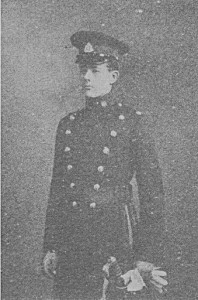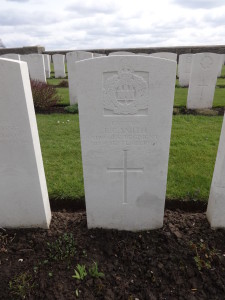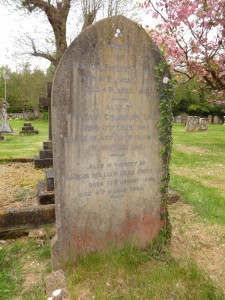 Regiment: 2nd Battalion, Suffolk Regiment
Regiment: 2nd Battalion, Suffolk Regiment
Date & place of birth: 17 April 1889 in Kearsney, Kent
Date & place of death: 30 September 1915 (aged 26) at Hooges, Belgium
Captain Edward Corrigan Smith was born into an army family and had served in Nigeria before the war, before becoming ill. He was killed within three months of returning to active service.
Family background
Edward Corrigan Smith (known to his family as “Corrigan”) was born in Kearsney, near Dover in Kent on 17 April 1889 and baptised at nearby Temple Ewell on 2 June. His parents were Francis (1855–1915) and Charlotte Louisa Smith (born 1855). His father was a major in the East Kent Regiment (The Buffs). By 1911, the family were living at The Mill House in Terwick.
His uncle was Sir William Rose Smith KCVO, CB, an eminent barrister who lived at Greatham Moor near Liss.
Education
Corrigan was educated at Tonbridge School in Kent between 1902 and 1907. At school, he became a lance-corporal in the Cadet Corps.
After leaving school, he spent two years at the Royal Military College at Sandhurst from where he graduated in 1909 with the rank of Second-Lieutenant in the Suffolk Regiment.
Military career
On joining his regiment, he was initially posted to the Mediterranean serving for short periods in Malta, Cyprus and Egypt.
In 1912, at his request, he was seconded from his regiment to join the West African Frontier Force under the Colonial Office, serving in Northern Nigeria at Lokoja. After a year, he contracted sleeping sickness (trypanosomiasis) and returned to England in the winter of 1913–14 to recuperate.
In the autumn of 1914, he had recovered sufficiently to be posted for light duty at the regimental depot at Bury St Edmunds in Suffolk. The following July, he was passed fit for active service and was sent to France on 6 July 1915 to join the 2nd Battalion of the Suffolk Regiment. Between July and September, the battalion were engaged in fighting in the Ypres salient at Bellewaarde and Hooge.
Death and commemoration
In late September 1915, the battalion were holding the trenches at Hooge, where Corrigan Smith was killed on 30 September.
In a letter to the family, a fellow officer wrote of Smith’s death:
I was wounded in the same attack in which your brother was killed. About September 28th, the Germans blew up, by means of a mine, a portion of the trenches held by the Regiment on our right, occupying the mine crater and a portion of our trenches. A day or two afterwards, we were ordered, in conjunction with the bombers of the two Regiments, to retake the lost trenches and, if possible, the crater. We regained a significant portion of the trenches, but were unable to get the crater. Your brother was hit early in the attack and killed instantaneously.
Your brother’s loss is keenly felt by all who knew him, as, apart from his being a keen, sound soldier and a brave man, he was exceedingly popular with everyone, and we all feel that we have lost one of the best.

Smith was buried in Bedford House Cemetery just south of Ypres. He is commemorated on the Tonbridge School Roll of Honour as well as on the war memorial at Trotton.
Subsequent family history

Corrigan Smith’s father had died at home six months before he was killed, in April 1915 and was buried in St George’s churchyard. The family grave also remembers Corrigan, although the date of death is incorrectly stated as 1 October 1915, and his brother, Francis William Head Smith CIE who had a long distinguished service with the India Office and died in 1964.
Principal Sources
In Life And In Death They Were Not Divided – The Friends Of The Suffolk Regiment